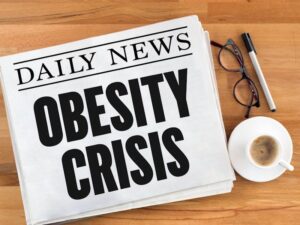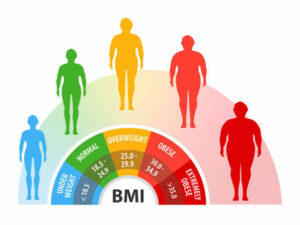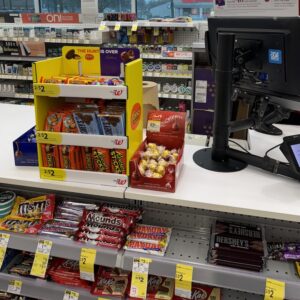Taking On the Obesity Epidemic
World Obesity Day was Monday, March 4. It’s a day established by the World Health Organization that calls for “a cohesive, cross-sector response to the obesity crisis.” It’s a day to bring awareness to the obesity epidemic and talk about possible solutions. Because obesity represents a problem that shakes the foundations of our health system and affects our economics.
According to a new worldwide study published last week in The Lancet medical journal, over the past three decades, obesity rates have quadrupled among children and more than doubled among adults.

One in eight people globally now live with obesity.
Our global obesity number has crossed the billion-person threshold, which is seen as a sign of worsening nutrition. The high prevalence of obesity also raises the risk of leading causes of death and disease such as high blood pressure, cancer, and diabetes. The research pulled data from more than 3,600 individual studies and found that from 1990 to 2022, the global rate of obesity in women more than doubled from 8.8% to 18.5%, and nearly tripled in men, from 4.8% to 14.0%.
In America, just over four in 10 adults and two in five kids are now classified as obese, which according to the World Health Organization, is a body mass index (BMI) over 30. BMI is calculated by dividing your weight in kilograms by your height in meters squared. The National Institutes of Health have a simple BMI calculator on their website where you input your weight in pounds and your height in feet and inches.
A lot has been written about how BMI isn’t always the most accurate measurement for determining whether somebody is of “normal weight”—especially anyone with more than average muscle mass. But the statistics tell us that the number of people with a BMI over 30 now exceeds a billion globally. And the research tells us that having a BMI over 30 increases a person’s risk of just about everything.
If you want a more accurate measure of whether you’re obese, just measure your waist and your hips. If your waist is as big around as your hips, you’re obese, regardless of your BMI. The World Health Organization is starting to use waist-to-hip ratio as an indicator of increased risk of heart disease and other conditions linked to obesity.

New obesity drugs such as Novo Nordisk A/S’s Wegovy and Eli Lilly’s Zepbound could be an $80 billion market by 2030. However, these drugs will not solve the problem. The real issue in obesity is poor food choices and low access to healthy foods. A drug can’t change those issues.
The elephant in the room is the evolving obesity culture we live in. Let’s consider a few examples of this culture shift.
The most expensive real estate in most communities is dedicated to gas stations. Everybody has to get gas, right? Most gas stations used to be service stations where you could get your car worked on. Not anymore. Gas station owners figured out they can make a lot more money selling donuts, pop, and candy than they can fixing cars. All those candy displays at the gas stations are there because people buy a lot of candy, especially king size candy bars.
And what about the drug stores. A drug store or two occupies every corner in every community. They provide life-saving and life-changing drugs to those who need them. But what do they try to sell you on your way out the door? Lots and lots of candy and snack foods. Every drug store you go into has stacks and stacks of candy bars and ultra-processed snacks displayed under the check-out counter, in the aisles leading to the checkout counter, and on every endcap. And as one last temptation, there’s usually a stack of candy bars right next to the cash register.
It’s almost criminal. When we go to the drug store to get medication for diabetes, high blood pressure, or high cholesterol, the drug store pushes, and pushes, and pushes us to buy more of the things that gave us those diseases. Stores place those candy bars by the cash register because they know we love to impulse buy.
Another aspect of the obesity culture is the size of everything we eat and drink. The term “portion distortion” emerged from an academic article published by the University of North Carolina in the early 2000’s that evaluated nutrition trends of more than 60,000 Americans. The study found that from 1977 to 1996, portion size (the amount of a particular food we eat) grew tremendously both inside and outside the home. And they’ve done nothing but continue to grow since then.

Try finding a 12 ounce can of soda at a gas station or convenience store. I checked recently, and I couldn’t find anything smaller than 16.9 ounces. The more you buy, the more you will drink. And the more you drink, the more likely you are to keep buying more. That’s because sugar is the most addictive drug in America.
At the beginning of the 20th century, the average grocery store had about 100 items. Your great grandmother would have recognized all those items as food. Today the average grocery store has more than 40,000 items, most of which are not food. Michael Pollin, author of In Defense of Food, says that most of what we eat isn’t food at all. It’s what he calls “edible food-like substances.” These foods are highly palatable, easily digestible, highly addictive, and they contain lots of ingredients that can wreck your health.
Most of the 40,000 new foods we’ve started consuming in the past 100 years are ultra-processed. Ultra-processed foods are defined as shelf-stable convenience foods containing five or more ingredients that are almost never used in home kitchens, such as preservatives, artificial colors, and compounds that add texture or enhance taste. According to some estimates, nearly 60% of the daily calories U.S. adults consume are from ultra-processed foods. It’s worse for kids and teenagers whose diets are almost 70% ultra-processed.
These are just a few examples of how our culture has become obesogenic. It’s great that the World Health Organization has designated March 4th as a day to bring awareness to the obesity epidemic. But a lot more needs to be done. I would like to believe we could easily solve the problem by changing the food industry, getting the pop and candy out of the gas stations, and making the drug stores operate with more integrity. That will never happen. There’s too much money involved.
But we can individually do a lot to promote change. First, just stop buying pop, candy, and ultra-processed foods. If enough people change their buying habits, the food industry will start to listen. Always be an example when you eat with friends and family. Be obsessed about the fact that you must eat two servings of fruit and four servings of vegetables every day. Drink your water all the time. Obsess about the fact that you will not eat anything that contains industrial seed oils or is too processed. If enough people stop buying “bad” foods, the food industry will have to shift. They already are.
And tread lightly with your friends. Instead of trying to tell them what to eat, just set an example by being radically different. Maybe they will notice and ask why you eat so differently.
Taking on the obesity epidemic won’t be an easy task. But if we all work at it, we can make a difference.
Stay Strong,
Bo Railey

